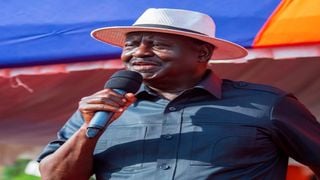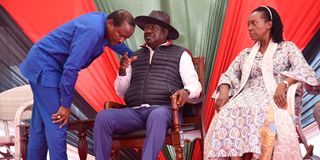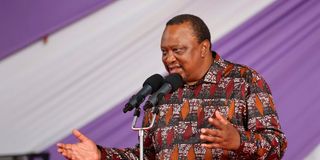
Azimio leader Raila Odinga. Ms Karua and Mr Wamalwa have gone against their boss, Mr Odinga, and opposed the Bomas report and call for a referendum.
| FilePolitics
Premium
Why split in Raila’s Azimio over talks report a blessing for Ruto, Kenya Kwanza
What you need to know:
- A united opposition would have given President Ruto and his administration a hard time to govern the country.
- Cracks in the opposition following the release of the NADCO report have turned out to be Mr Odinga’s headache.
The split in Raila Odinga’s Azimio la Umoja One Kenya coalition over the National Dialogue Committee (NADCO) report is proving to be a blessing for President William Ruto’s Kenya Kwanza, which has been under pressure from a united opposition one year after the hotly contested election.
Mr Odinga’s camp through its anti-government protests pushed for the talks with the Kenya Kwanza side before President Ruto yielded to dialogue following the intervention of the international community.
But the cracks in the opposition camp following the release of the report have turned out to be Mr Odinga’s headache as the President’s camp appears to have won in the talks after it turned down the proposal to reduce the cost of living which had been Azimio’s main agenda.
It is the lack of necessary measures to address the high cost of living that has left cracks in the opposition, with Azimio council chairman—former president Uhuru Kenyatta—Narc Kenya leader Martha Karua and DAP-Kenya’s Eugene Wamalwa pulling from in one side, with Mr Odinga and Wiper leader Kalonzo Musyoka on the opposite side.
Fresh mandate
Coupled with his raid of opposition party members that has created renegades in opposition circles, President Ruto steadily appears to be succeeding in dividing the opposition.

Wiper Party leader Kalonzo Musyoka (left), Azimio la Umoja leader Raila Odinga and Narc Kenya leader Martha Karua during a media briefing at Jaramogi Oginga Odinga Foundation Center in Nairobi on May 1, 2023.
The President has managed to woo to his side a section of Jubilee and ODM party legislators who have vowed to work with the government, even as Mr Odinga pushes for legislation to push them to seek a fresh mandate.
“We agreed to dialogue, formed a team and had four issues as Azimio. We have cost of living, audit of elections, fidelity to political parties and reconstitution of IEBC as our main issues.”
“However, they agreed to the 2022 elections audit, reconstitution of IEBC and fair selection of commissioners, law change to end party hopping that you either resign or party expels you and you seek fresh mandate and only the cost of living was not addressed because they refused insisting that’s the duty of government. We have since agreed with the report and decided that we shall make noise over this until they give in,” Mr Odinga said in Kisumu on Saturday.
Also Read:Inside President Ruto’s Nyanza road plan
Speaking at the thanksgiving ceremony of Kisumu Central MP Dr Joshua Oron, Mr Odinga said he was busy strengthening his party ODM through mass recruitment drive, adding that he will not call for protests at the moment.
“When we went to the streets, some people said we were interfering with their businesses. Now they are the ones asking where Baba is as Ruto’s high taxes continue to hit them. I’m telling them to reap where they sowed,” Mr Odinga declared.
By the opposition leader sticking to his guns over the report and ruling out any street protests—at least for now—it is almost clear that unity in his camp may not come soon as Ms Karua and Mr Wamalwa have insisted the report must be rejected since it does not address the concerns of the public.

National Dialogue Committee co-chairpersons Kalonzo Musyoka and Kimani Ichung'wah flanked by committee members present their final report at the Hilton Garden Inn on November 25, 2023.
This would ultimately benefit President Ruto who is keen on a divided opposition to be able to seamlessly govern the country.
Wiper party vice chairman Mutula Kilonzo Jnr agrees that the divisions in Azimio would only work in favour of Kenya Kwanza.
“Since it was their project (NADCO report) to find solutions, you can bet the ruling party is rolling with laughter,” Mr Kilonzo told Nation.
He pointed out that the divisions in Azimio ranks was “very unfortunate and disconcerting.”
“It is a replica of our disorganisation before and after the elections. Up to 45 Kenyans, some of them teens, were shot during the maandamano protests. Kenyans expected Azimio to lead in finding solutions to the problems bedevilling them, but instead, the leaders are disagreeing about a report that hardly answers the concerns of Kenyans. It is a serious dereliction,” Mr Kilonzo said.
Gem MP Elisha Odhiambo suggested that the divisions in Azimio are likely to lead to new formations in the new year.
“New alliances will be formed from January. Politicians are selfish, ambitious individuals and the division was bound to happen,” Mr Odhiambo said.
He went on: “l believe Kenyans now know that Martha and Eugene were stooges of some individual who wanted to control the outcome of the talks. The President has been vindicated.”
His Uriri counterpart Mark Nyamita pointed out that the decision by President Ruto and Mr Odinga to support the NADCO report “is not only the best, but the most patriotic in the circumstances”.
“Martha and Eugene are inconsequential though they are entitled to it,” said Mr Nyamita.
But Makueni senator Dan Maanzo insists there are no divisions in Azimio, adding that Ms Karua and Mr Wamalwa’s sentiments on the report have been “exaggerated”.
“They have freedom of expression and will be well accommodated in Azimio.
Political analyst cum governance expert Javas Bigambo terms the NADCO report as “a political tranquilliser, a compromise that cooled the political temperatures in the country.”
“The report's recommendations, if implemented, will definitely have progressive positive impacts on the fabric of our democracy. The fact that Azimio partners are not agreeing on whether to embrace or reject the report is of negative consequence to Azimio. What is true is that Martha Karua and Eugene Wamalwa want a political bargain beneficial to them, and Uhuru Kenyatta is not at ease with a settled political atmosphere,” Mr Bigambo explained.
Also Read: Supreme Court puts a final end to BBI

Former President Uhuru Kenyatta addresses the congregation at Full Gospel Church in Mwingi, Kitui County, on Sunday, November 19.
He said that Mr Kenyatta was pushing for the rejection of the NADCO report to create an “unstable political environment possibly so that Kenya Kwanza under President Ruto does not get a good environment to implement its manifesto fully, so that he (Uhuru) gets to create a faction to face Ruto in 2027.”
Another analyst, Mr Dismas Mokua, argues that Ms Karua and Mr Wamalwa only want to use opposition to NADCO report for brand positioning ahead of the 2027 presidential elections, adding: “Their parallel position is not material and will not shape Kenya’s political trajectory since they neither control nor influence key political and economic variables.”
“The duo are, however, likely to suffer from brand dilution because Kenyans have capacity to identify their primary motivation in opposing the NADCO report,” says Mr Mokua.
Ideological differences
He said their position on the NADCO report is not informed by ideological or intellectual differences, but a desire to pursue populist politics.
“Both were part and parcel of the Azimio leadership team that was involved in the design of NADCO terms of reference. Mr Wamalwa was a member of the NADCO team although his participation and contribution is said not to have been aligned with Azimio aspirations.”
Mr Mokua however, noted that the duo’s opposition is a blessing to the country because NADCO proposals can now be discussed and reviewed without the “shackles and encumbrances of 2027 presidential elections”.





